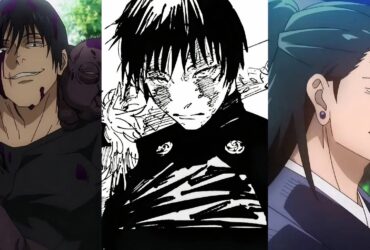Key Takeaways
- Japan U20 uses a 4-3-3 formation to balance attack and defense effectively.
- The Iron Wall Quartet provides an impenetrable defense against opponents.
- Sae Itoshi’s strategic playmaking and talented strikers propel Japan U20’s game plan.
With their fate in their hands, Japan’s U20 football team prepares to play against the makeshift Blue Lock Eleven of egotistical strikers who are desperate to make a name for themselves on the big stage. Since their opponents are expected to play an offensive brand of football, the Japan U20 team needs a game plan that takes control of the midfield and neutralizes the threat posed by Blue Lock’s best strikers.
The team’s coach, Yasumori Hoichi, when posed with these tactical problems, comes up with innovative strategies to help his team flourish. In this article, we look at Japan U20’s starting XI to understand their game plan and how each player fits into their role.

Related
Blue Lock: Every Main Character’s Age, Height, And Birthday
Blue Lock features an exciting story and a fantastic cast. Here’s every main character’s age, height, and birthday.
The 4-3-3 Formation
A Balanced Tactical Setup
The Japanese U20 team chooses the 4-3-3 formation in the game against Blue Lock Eleven. This tactical setup strategically balances attack and defense to preserve authority over the midfield while providing a flawless shift into defensive or offensive play.
The formation bolsters the defense by keeping four players in strategic positions, two of which are center-backs who are expected to counter the forwards. At the same time, the other two are full-backs who are positioned to defend the flanks. Japan’s U20 team has two defensive midfielders and an offensive midfielders. While the former duo is required to fall back and stop an oncoming attack, the latter is expected to support the forwards in their offensive plays by creating goal-scoring opportunities.
Japan’s U20 team’s offense is bolstered by the presence of three talented forwards who are always looking to create chances for their team. In addition to these ten players, Oliver Aiku’s team has Gen Fukaku, an experienced goalkeeper who ensures the defensive line remains resilient against formidable opponents.
Japan U20’s Defense
The Iron Wall Quartet
In football, preventing goals is as important as scoring them. Japan’s U20 team has a tough defense that makes it hard for strikers to penetrate their backline and create goal-scoring opportunities. The Iron Wall Quartet, comprising Oliver Aiku, Teppei Neru, Kazuma Nio, and Miroku Darai, stands as an immovable force that is hard to pass through. The four defenders are extremely adept at leaving no weak spots while supporting each other to play at their best.
People often liken Strikers as Robbers and Defenders as Cops. So, on my watch, I’m not letting any Robbers steal any goals.
Perhaps the greatest challenge for any forward while playing against Japan’s U20 is the unwavering coordination of the Iron Wall Quartet. Having played alongside one another, they understand each other’s game and are well aware of their weaknesses. They do an excellent job of playing to their strengths, giving the rival strikers almost no leeway to exploit gaps or vulnerabilities in the defense. The mutual understanding among Japan’s U20 defenders makes them unpredictable and difficult to keep up with.
While Teppei Neru, Kazuma Nio, and Miroku Darai are good players, it is Oliver Aiku whose presence makes them an exceptional defensive unit. Oliver is well-acquainted with the thought process of a striker and is extremely good at predicting the offensive flow of the game to spoil scoring chances. In several instances, he uses his dominant physicality and spatial awareness to stand as a wall between forwards. If everything fails, Oliver Aiku relies on his metavision and flow state to adapt in real time to neutralize threats with frightening accuracy.
Japan U20’s Midfield
The Well-Balanced Gameplan
The midfield controls the flow of the game. Therefore, teams must come up with a strategy that does not leave their defenses vulnerable and, at the same time, allows strikers to play aggressively to put the opponents on the back foot. While there are several tactical approaches to achieve this balance, Japan U20 comes up with a genius plan that relies on the superhuman footballing talent of Sae Itoshi.

Related
Blue Lock’s Top 6, Explained
Jinpachi Ego’s special facility houses the best players from the country. Here’s why the Top 6 stand out.
Japan U20’s team goes with three midfielders in the game against Blue Lock Eleven. Their 4-3-3 formation does not give much room for experimentation or unnecessary risks. Despite having the Iron Wall Quartet in the defense, coach Yasumori Hoichi feels that he needs to further strengthen the defensive unit by providing some cover in the midfield as well. This approach is understandable since they are playing against a makeshift team of egotistical strikers who will not let any chance to score a goal slip from their hands.
In an effort to bolster the defense further, Hoichi has placed two defensive midfielders, Hayate Haru and Darai Miroku. Whenever the opponents are in possession of the ball, Hayate is entrusted with the responsibility of pressuring them into making a pass. With Darai Miroku closely watching the drama unfold, it becomes tough to get through these midfielders to challenge the Iron Wall Quartet.
Football is, at its core, a sport about scoring goals even at the expense of your teammates. The best player is the one that scores the most.
Apart from the two defensive midfielders, the Japan U20 starting XI includes Sae Itoshi as the only offensive midfielder, who is responsible for supporting the three forwards as a playmaker. Sae, being Japan’s best footballer, understands the game better than anyone else on the field. With his nearly invincible playing style, he possesses the talent to expose the vulnerabilities in the opposition’s defenses. While Sae respects the game enough to play at his position and follow the team’s plan, what makes him truly dangerous is the fact that he can single-handedly score a goal if his teammates let him down on the field.
Japan U20’s Forward
The Talented Striker Trio
Winning a football game depends heavily on the team’s strikers as they are the ones who are expected to do the bulk of goal-scoring. They also keep the opposition under constant pressure by attacking relentlessly, forcing the defensive line to stay on their toes. Japan U20’s team, having bolstered their defense, picks three forwards in their starting formation. Shuto Sendo, Teru Kitsunezato, and Kento Cho have a ton of experience. Since they have played together in the past, the trio understands each other’s game inside out.
With Sae Itoshi’s support as the playmaker, they could have posed a threat to Blue Lock Eleven’s defenses. However, the trio lacks the egoism that Jinpachi Ego deems essential for a striker to flourish. In the game against Blue Lock, their success or failure depends heavily on their attitude to go all-in. In the first half, Ego’s analysis turns out to be quite accurate as Ryusei Shido has to be subbed in to replace one of the forwards.

Read More
Blue Lock: 6 Best Arcs In The Manga
Blue Lock has witnessed several interesting arcs over the years. These are the best of the bunch.

- Release Date
- October 8, 2022
- Cast
- Ricco Fajardo , Drew Breedlove , Alex Horn , Mark Allen Jr.
- Writers
- Taku Kishimoto
Source link












Leave a Reply